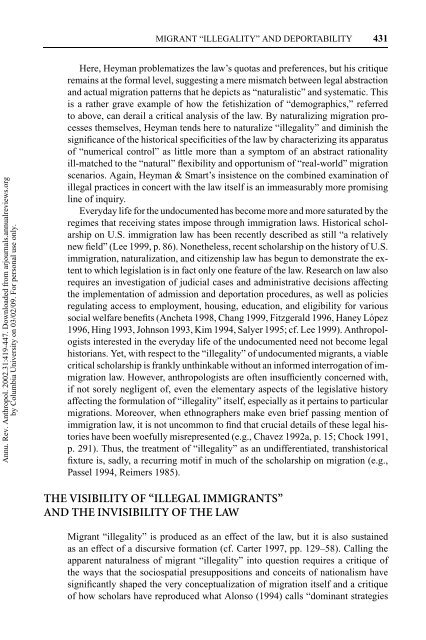migrant “illegality” and deportability in everyday life - Nicholas De ...
migrant “illegality” and deportability in everyday life - Nicholas De ...
migrant “illegality” and deportability in everyday life - Nicholas De ...
Create successful ePaper yourself
Turn your PDF publications into a flip-book with our unique Google optimized e-Paper software.
Annu. Rev. Anthropol. 2002.31:419-447. Downloaded from arjournals.annualreviews.org<br />
by Columbia University on 03/02/09. For personal use only.<br />
MIGRANT “ILLEGALITY” AND DEPORTABILITY 431<br />
Here, Heyman problematizes the law’s quotas <strong>and</strong> preferences, but his critique<br />
rema<strong>in</strong>s at the formal level, suggest<strong>in</strong>g a mere mismatch between legal abstraction<br />
<strong>and</strong> actual migration patterns that he depicts as “naturalistic” <strong>and</strong> systematic. This<br />
is a rather grave example of how the fetishization of “demographics,” referred<br />
to above, can derail a critical analysis of the law. By naturaliz<strong>in</strong>g migration processes<br />
themselves, Heyman tends here to naturalize <strong>“illegality”</strong> <strong>and</strong> dim<strong>in</strong>ish the<br />
significance of the historical specificities of the law by characteriz<strong>in</strong>g its apparatus<br />
of “numerical control” as little more than a symptom of an abstract rationality<br />
ill-matched to the “natural” flexibility <strong>and</strong> opportunism of “real-world” migration<br />
scenarios. Aga<strong>in</strong>, Heyman & Smart’s <strong>in</strong>sistence on the comb<strong>in</strong>ed exam<strong>in</strong>ation of<br />
illegal practices <strong>in</strong> concert with the law itself is an immeasurably more promis<strong>in</strong>g<br />
l<strong>in</strong>e of <strong>in</strong>quiry.<br />
Everyday <strong>life</strong> for the undocumented has become more <strong>and</strong> more saturated by the<br />
regimes that receiv<strong>in</strong>g states impose through immigration laws. Historical scholarship<br />
on U.S. immigration law has been recently described as still “a relatively<br />
new field” (Lee 1999, p. 86). Nonetheless, recent scholarship on the history of U.S.<br />
immigration, naturalization, <strong>and</strong> citizenship law has begun to demonstrate the extent<br />
to which legislation is <strong>in</strong> fact only one feature of the law. Research on law also<br />
requires an <strong>in</strong>vestigation of judicial cases <strong>and</strong> adm<strong>in</strong>istrative decisions affect<strong>in</strong>g<br />
the implementation of admission <strong>and</strong> deportation procedures, as well as policies<br />
regulat<strong>in</strong>g access to employment, hous<strong>in</strong>g, education, <strong>and</strong> eligibility for various<br />
social welfare benefits (Ancheta 1998, Chang 1999, Fitzgerald 1996, Haney López<br />
1996, H<strong>in</strong>g 1993, Johnson 1993, Kim 1994, Salyer 1995; cf. Lee 1999). Anthropologists<br />
<strong>in</strong>terested <strong>in</strong> the <strong>everyday</strong> <strong>life</strong> of the undocumented need not become legal<br />
historians. Yet, with respect to the <strong>“illegality”</strong> of undocumented <strong>migrant</strong>s, a viable<br />
critical scholarship is frankly unth<strong>in</strong>kable without an <strong>in</strong>formed <strong>in</strong>terrogation of immigration<br />
law. However, anthropologists are often <strong>in</strong>sufficiently concerned with,<br />
if not sorely negligent of, even the elementary aspects of the legislative history<br />
affect<strong>in</strong>g the formulation of <strong>“illegality”</strong> itself, especially as it perta<strong>in</strong>s to particular<br />
migrations. Moreover, when ethnographers make even brief pass<strong>in</strong>g mention of<br />
immigration law, it is not uncommon to f<strong>in</strong>d that crucial details of these legal histories<br />
have been woefully misrepresented (e.g., Chavez 1992a, p. 15; Chock 1991,<br />
p. 291). Thus, the treatment of <strong>“illegality”</strong> as an undifferentiated, transhistorical<br />
fixture is, sadly, a recurr<strong>in</strong>g motif <strong>in</strong> much of the scholarship on migration (e.g.,<br />
Passel 1994, Reimers 1985).<br />
THE VISIBILITY OF “ILLEGAL IMMIGRANTS”<br />
AND THE INVISIBILITY OF THE LAW<br />
Migrant <strong>“illegality”</strong> is produced as an effect of the law, but it is also susta<strong>in</strong>ed<br />
as an effect of a discursive formation (cf. Carter 1997, pp. 129–58). Call<strong>in</strong>g the<br />
apparent naturalness of <strong>migrant</strong> <strong>“illegality”</strong> <strong>in</strong>to question requires a critique of<br />
the ways that the sociospatial presuppositions <strong>and</strong> conceits of nationalism have<br />
significantly shaped the very conceptualization of migration itself <strong>and</strong> a critique<br />
of how scholars have reproduced what Alonso (1994) calls “dom<strong>in</strong>ant strategies





